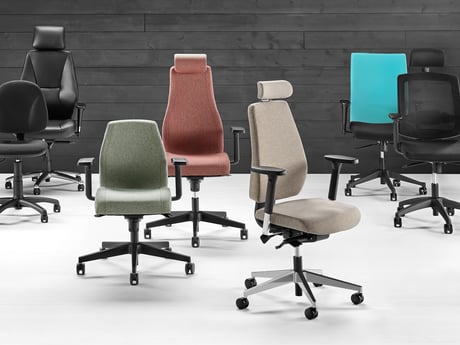How to reduce MSDs for assembly workers

Within the engineering and industrial sectors, pain caused by strain injuries is a common cause of long-term sick leave due to repetitive movements and uncomfortable postures. You can reduce the risk of musculoskeletal disorders (MSDs) and repetitive strain injuries (RSIs) to achieve more productive working days by choosing furniture adapted to your work tasks.
Workbenches
Choosing a height-adjustable workbench makes it easier to adjust the working height to suit both your task and your height. If only one person regularly uses the workstation, a manually adjustable workbench can be set at the best height for their usual work tasks. A more ergonomic solution is a sit-stand workbench, which allows the user to switch between sitting and standing for different tasks and can be set in the correct position for users of any height. Many workstations also offer the option of integrated storage under or at the rear of the bench so that tools and packing materials are close at hand and can be reached without stretching or bending.
Monitor arms and document holders
Do you have a computer monitor on the workbench or frequently need to refer to documents? By fitting a document holder and/or adjustable monitor arm you can place these items at eye level, which prevents neck strain as you don’t need to move your whole head to look at them, you can just glance over instead.
Anti-fatigue mats
For long hours spent working standing up, an anti-fatigue mat is essential. Standing on cold, hard concrete floors puts a lot of pressure on your lower joints leading to pain in the feet, knees and hips with referred pain in the lower back. This type of support matting encourages micro-movements that significantly improve blood flow and oxygen to the heart and evenly distribute pressure throughout the lower limbs. This reduces the strain on muscles and joints and helps alleviate any associated pain. It is a small investment that makes a big difference in terms of health and productivity.
Draughtsman’s chairs
Many of today's factory chairs feature an ergonomically designed backrest and seat to provide effective support and relief for your upper body and legs. A good chair has an adjustable seat angle, so you can adjust your sitting posture while keeping the hip joint open, which facilitates blood circulation and improves the alignment of your spine in relation to your pelvis to stop you from slouching. If you often switch between sitting and standing work, there are special work chairs that facilitate the movement from a sitting to standing position.
Wheeled stool
A wheeled stool is a good alternative to a traditional draughtsman chair if you often have tasks where you must squat, kneel or bend down. This type of stool is much lower to the ground so you can get close to your work but relieves your back, knees and ankles compared to uncomfortable and unhealthy positions. The chairs are often equipped with a tool shelf under the seat so that you always have the tools you need close at hand and don’t need to get up and down.
Work lighting
Poor lighting is a common cause of headaches and eye strain. Invest in good work lighting with a flexible arm that can be adjusted to provide effective spot lighting for assembly and electronics work, for example. Some work lights even have a custom colour spectrum to reproduce colours and details in an optimal way.
Tool panels
Bench-mounted tool panels, louvre panels and hanging rails give you a good overview of any equipment and small parts you need to be able to complete your work. By hanging the tools instead of keeping them in nearby cabinets or drawers, you don’t need to bend down or leave your workstation to find what you need, making your work more efficient and more ergonomic.


